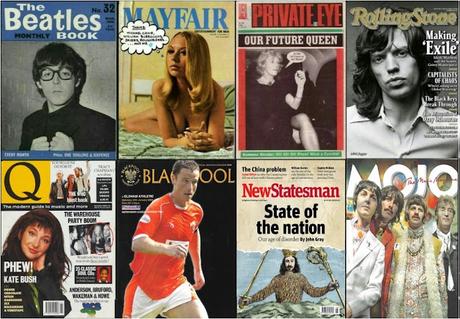So when and why did a word meaning shop or storehouse get appropriated as the name for a printed publication? And not any sort of publication, for a magazine is different from a journal, a newspaper, a pamphlet and a book - though curiously, when I had a paper round in my early teens, the magazines we delivered alongside newspapers were not known as such but as books (don't ask me why) and comics were a separate beast all together.

comic readers outside the store, Manhattan 1947 (photo credit: Ruth Orkin)
We were never allowed comics as children, certainly not Beano or Dandy, frivolous rags, nor the slightly more upmarket Eagle and Victor, and not even Boy's Own (which had begun life as a religious publication) or Look and Learn, which billed itself as an educational magazine. I am still brimming with remembered indignation as I write this. Our pocket money was not ours to do with as we wished!Good heavens, we weren't even allowed a television set until I was nearly eleven years old - and that only because my younger brother was always sneaking off to other people's houses to watch it and my parents never knew where he was - so when my school friends were all chatting about Blue Peter, Bootsie and Snudge, Fireball XL5, Noggin the Nog or Whirlybirds, I didn't have a clue.
But back to magazines. It is believed that they were so called because they were repositories of collected articles, a storehouse of writings that were not news but were pieces of topical interest by a variety of authors. They were published at regular intervals, not daily like newspapers, but weekly, monthly or quarterly (thus earning the additional tag of periodicals) and they were often available on subscription to guarantee a core readership.
The first documented example of a publication worthy of the name magazine appeared (fittingly enough) in Germany in 1663. Published monthly, the Erbauliche Monaths Unterredungen was a literary and philosophical trailblazer. It was followed by such titles as Gazette de France, The Scots Magazine, The Gentleman's Magazine and a host of famous names, Harpers, Life, Punch, The New Yorker, Tatler, Vogue, magazines catering to every demographic, hobby and lifestyle.
As for my own love affair with the magazine, that began with The Beatles Monthly in the early 1960s. In this respect, in common with so many other facets of life for us teenagers, the Beatles were our impetus for going against the strictures of our parents and generational conformity. It was a small but vital battle which saw me insisting on my right to spend my pocket money as I saw fit. The Beatles Monthly (also called a book, note), cost the princely sum of 1/6d per month. I was loyal to it for the majority of the decade, and how I wish now that I'd had the foresight not to bin the lot some years later when my parents moved house.
Airfix Magazine (for plastic modellers) was soon consuming another 2 shillings per month as the 1960s rolled on, testament to my main hobby of making aircraft construction kits and was joined along the way by something called Profile Publications, a series of monographs each one devoted to a different classic aeroplane. I donated all of those two sets of magazines to the Modelling Club when I left school in 1971, on the way to becoming a young man - who now read Mayfair, the satirical Private Eye and Rolling Stone (see below) alongside International Times and Marxism Today. We men are such complex creatures.

60 years a slave to the periodical
There was an extended period from the 1980s into the new millennium when I not only purchased magazines but wrote for them as well as a freelance music journalist, though that's a whole other tale.Suffice to say that my magazine reading habits have largely centred around my abiding interests in rock music, football, social and political commentary with occasional forays into the world of science. Q was a staple for a while, as were Dark Star, Freakbeat and Nuggets but then along came Uncut, Shindig! and MOJO. I did sell my entire collection of Q (issues 1 to 150) a decade or so ago, Ditto Dark Star, The house on the strand does not have room enough. My elder daughter gave me as a birthday present a subscription to MOJO for several years - see above, the periodical has just about come full circle - but I declined to renew it this year because I worry about the trees. We have online for so much now.
Funnily enough, I never bought or subscribed to poetry magazines. On reflection, that may have been a strange omission. And now, having been a member of the Poetry Society for s few years, I receive The Poetry Review on a quarterly basis, though I rarely dip into it. Is that a shocking admission? Perhaps we should move swiftly on!
To finish this week's edition, here's a new poem, a skewed take on...
Top Shelf TitlesHe chooses this shop because he knows the CCTV is broken the owner told him so,nonetheless he's always in disguisefalse beard, shabby coat, hat.He's not exactly furtive
though others may think him thatas he hangs back diffidentuntil the coast is clear,his surreptitious mannerborn of caution, for one can neverbe too careful nowadays.
Finally he stands alonebefore the racks of publicationsa proliferation of gaudy papand reaches up to the top shelf stocked with magazines in brown bagsonly their titles showing through slits.
They're placed high up by orderso as not to tempt, offendor worse still corrupt and incite:New Scientist, Politics Today, Nature.He chooses this month's Literary Reviewand always pays in cash.
Footnote in self-defence: I'm sure sharp-eyed readers will have noticed that Mayfair (as illustrated) also carried informative articles e.g. about the author William Burroughs, interviews with the likes of Michael Caine etc.☺
Thanks for reading, S ;-) Email ThisBlogThis!Share to TwitterShare to Facebook
